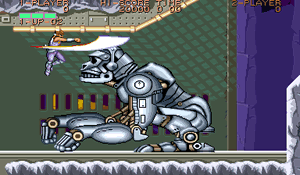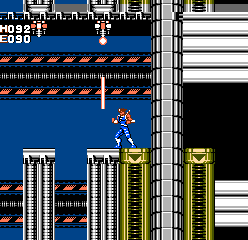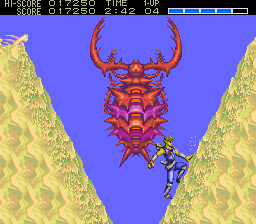He is one of Capcom’s most popular characters and a mystery among gaming heroes. For nearly two decades, gamers have followed the adventures of Strider Hiryu, mysterious defender of freedom, as he battles the Grand Master Meio. From the arcades, to the NES and Genesis, and finally to the Playstation, Strider is a franchise that has remained consistently original and refreshing, appearing every so often to show gamers that side-scrolling action titles are still a great way to spend an afternoon.
The funny thing is, young Hiryu didn’t make his debut in video games. He actually appeared first in a black and white manga that appeared between May and October 1988 in Monthly Comp Comics and was illustrated by Tatsumi Wada. Capcom was heavily involved with the project, and as a result interest in creating a game based on the character grew.
 Strider Hiryu himself is a much deeper character than you’d initially think. According to the manga, he was the youngest of the A-class Striders who retired after accidentally killing Mariya, the insane sister of another Strider. He is brought out of retirement by the director of the Striders, Matic, who sends him to kill his best friend Kain, or watch helplessly as thousands of innocent Muslims are killed. A tale of treachery and pain follows, resulting in Hiryu rescuing Kain, and destroying the corrupt Striders, along with the evil syndicate Enterprise and their mind-controlling device “ZAIN.”
Strider Hiryu himself is a much deeper character than you’d initially think. According to the manga, he was the youngest of the A-class Striders who retired after accidentally killing Mariya, the insane sister of another Strider. He is brought out of retirement by the director of the Striders, Matic, who sends him to kill his best friend Kain, or watch helplessly as thousands of innocent Muslims are killed. A tale of treachery and pain follows, resulting in Hiryu rescuing Kain, and destroying the corrupt Striders, along with the evil syndicate Enterprise and their mind-controlling device “ZAIN.”
The Games
The Capcom arcade game released in 1989, though bearing no resemblance to the manga, was still a big hit. It featured lush, colorful graphics and lots of action, which tended to stand out among the ever-increasing glut of beat-’em-ups that were filling arcades at the time. Gamers were enthralled with the mysterious ninja-like character and his massive plasma sword Falchion, as he cut a swath of destruction across such exotic locales as Siberia and the Amazon rain forest in search of the evil Grand Master. They were awed by the massive, detailed bosses that sometimes covered multiple screens. I still remember how impressed I was with that huge sphere-like thingie that sucked you into its gravitational field and flung you around like a rag doll. Just as impressive was the game’s soundtrack and generous use of voice samples, and there were several cut scenes in English, Japanese, and Russian.
We have to remember that the game was released during the cold war, which prompted a few jabs at the Soviet government. For example, though the official story says that the first level takes place in Kafazu, which is a small European country, the opening sequence of the game reads ” Kazakhstan CCP,” which just happens to be a nation in central Asia that was once a part of the Soviet Union. Soldiers in the game wear a variation of the Soviet uniform, and the Urobolos boss monster (that big snake-like creature ) is formed when the prime minister, who looks very much like former Soviet premier Mikhail Gorbachev, urges the other politicians around him to join together!
Sounds like a lot of story for a game that basically just has you run from left to right, hacking away at anything that moves, doesn’t it? Even though the storyline got lost along the way, the game itself still permeated personality and had gamers wondering “who was this guy?” and “where’d he come from?” Most importantly, it had them wondering whether they’d ever see him again.
Thankfully, they would. In 1989, Capcom released a version of the Strider for the 8-bit NES, which was a decidedly big step down from their powerful CPS arcade hardware. To make up for this, Capcom essentially made it into an entirely different game. To this day, Strider on the NES remains one of the seminal titles for the system, and is still a fan favorite. In truth, it is the most faithful version in that it closely follows the original manga. Gameplay is basically the same as in the arcade version, but there is now more of an adventure feel, and Hiryu can collect and store items for later use. Keys, message disks, and different types of boots are located in different areas, and must be found to be used. Furthermore, his sword, now renamed “cipher,” has been given a charge attack. These additions offered some excellent twists to the arcade formula, as it allowed players to revisit each locale, and access sections that had been previously off limits. Through Japan, Egypt, Africa, and other places, you’ll search for information about Kain and the evil syndicate that has corrupted the Striders.
 Needless to say, the game was a success, and left the public wanting more. Capcom obliged, but not in the way everyone expected. Instead of a sequel on the NES, gamers got a port of the arcade hit on a myriad of consoles, including the shiny new Sega Genesis (a Super Grafx version was cancelled). Whatever disenchantment Capcom’s business decision caused was quickly wiped away once people got to play the first-ever 8-meg cartridge. The Genesis version of Strider was spot-on, missing only some animation and background detail, as well as sporting an altered ending. Considering the scope of the transition, and the fact that nothing had ever been seen like it on a home console, the closeness of the port to the coin op original was most impressive, and the game went on to win several awards, including EGM’s 1990 Game of the Year. Strider was a success on all levels, giving Sega’s infant console the prestige and star power it needed to snatch gamers away from Nintendo, and offering Capcom a console to finally bring their arcade games home in the way they were meant to be even though they had to be reprogrammed for the Genesis (they had to license their games to Sega, due to Nintendo’s iron-clad licensing agreement which prevented them from being a 3rd party to any other console maker).
Needless to say, the game was a success, and left the public wanting more. Capcom obliged, but not in the way everyone expected. Instead of a sequel on the NES, gamers got a port of the arcade hit on a myriad of consoles, including the shiny new Sega Genesis (a Super Grafx version was cancelled). Whatever disenchantment Capcom’s business decision caused was quickly wiped away once people got to play the first-ever 8-meg cartridge. The Genesis version of Strider was spot-on, missing only some animation and background detail, as well as sporting an altered ending. Considering the scope of the transition, and the fact that nothing had ever been seen like it on a home console, the closeness of the port to the coin op original was most impressive, and the game went on to win several awards, including EGM’s 1990 Game of the Year. Strider was a success on all levels, giving Sega’s infant console the prestige and star power it needed to snatch gamers away from Nintendo, and offering Capcom a console to finally bring their arcade games home in the way they were meant to be even though they had to be reprogrammed for the Genesis (they had to license their games to Sega, due to Nintendo’s iron-clad licensing agreement which prevented them from being a 3rd party to any other console maker).
The Genesis wasn’t the only console to feature a notable version of Strider, and mention must be made of the game’s arduous voyage to NEC’s PC-Engine CD system. Originally slated as a Super Grafx title (you may remember that famous picture of Hiryu standing between bands of electricity in stage two), the project was cancelled when the console went under. It was revived in 1994 for the PC-Engine CD, and although the graphics and gameplay aren’t on par with the Genesis cart, there are a few distinguishing features for this release. First off, the soundtrack is absolutely beautiful, and the CD format finally brings out just how well-scored the game really is (could it be the arranged soundtrack found in the Playstation version that came packed with Strider 2?). Moreover, there are some impressive cut scenes with full voice work and character portraits, as well as an entirely new desert level, complete with its own boss! Even if it wasn’t as polished as the Genesis version, there simply was no excuse for NEC leaving this one behind. Of course, the same could probably be said for scores of PC-Engine and PC-Engine CD games…
So after two successful releases, Capcom should be ready to bring back Hiryu in some fashion, be it another arcade game or an original console release, right? Not exactly. In a move still questioned today, the company farmed out the franchise to U.S. Gold, who promptly attempted a cash run of their own right after Sega ported the original, and released the mediocre Journey from Darkness: Strider Returns for the Genesis, Game Gear, and numerous PCs in 1990. Developer Tiertex proceeded to rape the series of everything that had made it great. Remember that badass Meio? Well, he’s apparently not so ambitious anymore, and has settled for merely kidnapping women as opposed to taking over the world. Hiryu himself is nowhere to be seen, having now been replaced with a look-alike named Hinjo. Wait…what? It seems that Tiertex simply ripped some sprites from the Genesis classic, swapped the color palate, and called it a new game. Not even the awesome manga-inspired story was spared, as evidenced from this quote directly from the game’s instruction manual:
“This guy is like a bad habit, he just won’t go away. Now this Evil Master dude and his legions of nimrods are poised above the planet in a space station, ready to make the planet one big black hole. Not only that, those blasted automadions (space slang for funky robot type guys) have captured Lexia (Not the car, the babe!) and are holding her prisoner aboard their space station.”
Ok…that right there is reason enough for a death sentence. What the hell were these people thinking? What’s even worse is that the original Strider was straight forward enough that a sequel should have been incredibly simple to do right. Even the slightest bit of imagination injected into the process could have produced a better game than this, and that is probably the biggest injustice here. Journey from Darkness isn’t necessarily a bad game, it’s just not a Strider game. It’s akin to seeing a loved one revived as a mindless zombie; it’s them, it’s just not them.
I guess the U.S. Gold game left such a bad taste in Capcom’s mouth, that they shelved the series for almost a decade. It wasn’t until 1999 that Hiryu made his triumphant return to where he had made his gaming debut: the arcades. Beefed up and ready for action, Strider 2 went back the classic formula of side-scrolling action without any of the adventure elements from the NES version. Capcom retained the 2D gameplay of the first game, but added 3D backdrops to give it a more modern look. The new “2.5D” feel pleased gamers who fondly remembered the original, as well as those who raised in the modern era. Incredibly drawn cut scenes between each level made Hiryu appear more heroic and appealing than ever before and really gave the game more personality.
 In addition to all his standard moves, Hiryu could now do a double jump, and he also had a more powerful attack. Some say that he was a bit too powerful, and that this made the game far too easy. This problem reared its head again when Strider 2 was ported to the Playstation in 2000, giving players unlimited continues. The options menu allowed you to reduce Hiryu’s life bar, but some felt the challenge just wasn’t there (*note to gamers: don’t continue! Problem solved). Even with this minor complaint, Strider 2 was widely accepted and praised, especially since Capcom was nice enough to include a second disc with the original arcade Strider in the package. Now you could play through both great adventures on one console. I personally would have liked the NES game included as an extra, but beggars can’t be choosers, I guess. This was the last time Hiryu would star in his own game, though he did appear as a character in Capcom’s massive fighting extravaganza Marvel vs. Capcom, and returned for a second round a year later (he also showed up in Card Fighters Clash on the Neo Geo Pocket Color).
In addition to all his standard moves, Hiryu could now do a double jump, and he also had a more powerful attack. Some say that he was a bit too powerful, and that this made the game far too easy. This problem reared its head again when Strider 2 was ported to the Playstation in 2000, giving players unlimited continues. The options menu allowed you to reduce Hiryu’s life bar, but some felt the challenge just wasn’t there (*note to gamers: don’t continue! Problem solved). Even with this minor complaint, Strider 2 was widely accepted and praised, especially since Capcom was nice enough to include a second disc with the original arcade Strider in the package. Now you could play through both great adventures on one console. I personally would have liked the NES game included as an extra, but beggars can’t be choosers, I guess. This was the last time Hiryu would star in his own game, though he did appear as a character in Capcom’s massive fighting extravaganza Marvel vs. Capcom, and returned for a second round a year later (he also showed up in Card Fighters Clash on the Neo Geo Pocket Color).
Taking Things in Stride
Unfortunately, no other Strider games have been announced, and it remains to be seen whether or not Capcom would be willing to do another (can you say “PSP?”). With the almost decade-long gap between the original and the official sequel, it is still quite possible that Hiryu may yet see action on the next generation of consoles. One can only hope.
The complete release chronology is as follows:
- Strider, Arcade (1989)
- Strider, DOS PC (1989)
- Strider, NES (1989)
- Strider, Atari ST (1989)
- Strider, Amiga (1989)
- Strider, Commodore 64 (1989)
- Strider, Sinclair Spectrum ZX (1989)
- Strider, Genesis (1990)
- Journey from Darkness: Strider Returns, Genesis (1990)
- Strider II, Master System (1990)
- Strider II, Amiga (1990)
- Strider II, Atari ST (1990)
- Strider II, Commodore 64 (1990)
- Strider II, Sinclair Spectrum ZX (1990)
- Strider, Master System (1991)
- Journey from Darkness: Strider Returns, Game Gear (1994)
- Strider, PC-Engine (1994)
- Strider, Playstation [Bonus disc with Strider 2] (1999)
- Strider 2, Playstation (1999)
Sources
- Bousiges, Alexis. Strider Arcade Game Info. Arcade History Database. April 26, 2005 (latest edition).
- Game Info. PHM Shinobi Web Site.
- Game Info, multiple titles. Strider-Otaku.
- Mielke, James. Strider 2 review. GameSpot. March 3, 2000.
- Reis, Marcelo. Strider PC-Engine CD Review. Universo PC-Engine.
- Strangman, Rob. Strider 2: Journey from Darkness review. Classic Gaming.
- Zdyrko, David. Strider 2 Playstation review. IGN. July 27, 2000.
* Thanks to Kurt of Hardcore Gaming 101 for his contribution regarding the PC-Engine release.

Recent Comments